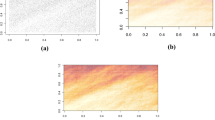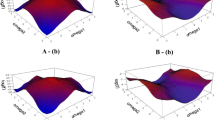Abstract
Detection and modeling the spatial correlation is an important issue in spatial data analysis. We extend in this work two different goodness-of-fit testing techniques for the spatial spectral density. The first approach is based on a smoothed version of the ratio between the periodogram and a parametric estimator of the spectral density. The second one is a generalized likelihood ratio test statistic, based on the log-periodogram representation as the response variable in a regression model. As a particular case, we provide tests for independence. Asymptotic normal distribution of both statistics is obtained, under the null hypothesis. For the application in practice, a resampling procedure for calibrating these tests is also given. The performance of the method is checked by a simulation study. Application to real data is also provided.



Similar content being viewed by others
References
Alonso FJ, Angulo JM, Bueso MC (1996) Estimation and smoothing from incomplete data for a class of lattice processes. Comm Stat Theory Methods 25:667–681
Besag JE (1974) Spatial interaction and the statistical analysis of lattice systems. J R Stat Soc Ser B 36:192–236
Brilinger DR (1974) Fourier analysis of stationary processes. Proc IEEE 62:1628–1643
Brilinger DR (1981) Time series. Data analysis and theory. Holden-Day, Oakland
González-Manteiga W, Cao R (1993) Testing the hypothesis of a general linear model using nonparametric regression estimation. Test 2:161–188
Chilès JP, Delfiner P (1999) Geostatistics. Wiley, New York
Cressie N (1993) Statistics for spatial data. Wiley-Interscience, New York
Crujeiras RM, Fernández-Casal R (2009) On the estimation of the spectral density of continuous spatial processes. Statistics (in press)
Crujeiras RM, Fernández-Casal R, González-Manteiga W (2007) Goodness-of-fit tests for the spatial spectral density. Technical report. Department of Statistics and Operations Research. http://eio.usc.es/pub/reports.html
Dahlhaus R, Künsch H (2000) Edge effects and efficient parameter estimation for stationary random fields. Biometrika 74:877–882
Dahlhaus R, Wefelmeyer W (1996) Asimptotically optimal estimation in misspecified times series models. Ann Stat 24:952–974
de Jong P (1987) A central limit theorem for generalized quadratic forms. Prob Theory Relat Fields 75:261–277
Diblasi A, Bowman AW (2001) On the use of the variogram in checking for independence in spatial data. Biometrics 57:211–218
Fan J, Zhang W (2004) Generalised likelihood ratio tests for spectral density. Biometrika 91:195–209
Fan J, Zhang C, Zhang J (2001) Generalized likelihood ratio statistics and Wilks phenomenon. Ann Stat 29:153–193
Fuentes M (2002) Spectral methods for nonstationary spatial processes. Biometrika 89:197–210
García-Soidán PH, Febrero-Bande F, González-Manteiga W (2004a) Local linear regression estimation of the semivariogram. Stat Prob Lett 64:169–179
García-Soidán PH, Febrero-Bande F, González-Manteiga W (2004b) Nonparametric kernel estimation of an isotropic variogram. J Stat Plan Infer 121:65–92
Goldberg D (1989) Genetic algorithms in search, optimization and machine learning. Addison-Wesley, Reading.
Guyon X (1982) Parameter estimation for a stationary process on a d-dimensional lattice. Biometrika 69:95–105
Härdle W, Mammen E (1993) Comparing nonparametric versus parametric regression fits. Ann Stat 21:1926–1947
Hart JD (1997) Nonparametric smoothing and lack-of-fit tests. Springer. New York
Maglione D, Diblasi A (2004) Exploring a valid model for the variogram of an isotropic spatial process. Stoch Environ Res Risk Assess 18:366–376
Martin RJ (1979) A subclass of lattice processes applied to a problem in planar sampling. Biometrika 66:209–217
McBratney AB, Webster R (1981) Detection of ridge and furrow pattern by spectral analysis of crop yield. Int Stat Rev 49:45–52
Paparoditis E (2000) Spectral density based goodness-of-fit tests for time series models. Scand J Stat 27:143–176
Porcu E, Crujeiras RM, Mateu J, González-Manteiga W (2009) On the second order properties of the multidimensional periodogram for regularly spaced data. Theory Prob Appl (SIAM) (in press)
Priestley MB (2000) Spectral analysis and time series. Academic Press, London
Robinson P (2007) Nonparametric spectrum estimation for spatial data. J Stat Plan Inference 137:1024–1034
Stute W (1997) Nonparametric model checks for regression. Ann Stat 25:613–641
Stute W, González Manteiga W, Presedo Quindimil M (1998) Bootstrap approximations in model checks for regression. J Am Stat Assoc 93:141–149
Whittle P (1954) On stationary processes in the plane. Biometrika 41:434–449
Yaglom AM (1987) Correlation theory of stationary and related random functions. Springer Series in Statistics. New York
Young LJ, Young JH (1998) Statistical ecology. Kluwer, Dordrecht
Zhang C, Dette H (2004) A power comparison between nonparametric regression tests. Stat Prob Lett 66:289–301
Zheng JX (1996) A consistent test of functional form via nonparametric estimation techniques. Journal of Econometrics 75:263–289
Acknowledgments
The authors acknowledge the financial support of the Ministry of Science and Technology and FEDER, project MTM2005-00820. Research of Rosa Crujeiras was partially supported by grant BES2003-0581 and Xunta de Galicia project PGIDIT06PXIB207009PR. In addition, research of Rubén Fernández-Casal was partially supported by Xunta de Galicia project PGIDIT05TIC00701CT. We would also like to thank two anoymous referees and the editor for making several suggestions which substantially improved the article.
Author information
Authors and Affiliations
Corresponding author
Appendix
Appendix
For the sake of simplicity, we just give the sketch of the proofs for the results in these work. Detailed proofs can be found in Crujeiras et al. (2007).
Lemma 1
Assume that assumption (2) is fulfilled and considerU k independent identically distributed random variables withE(U k ) = 1, Var(U k ) = 1 andE(U 4 k ) < ∞. Then,
where μ H and τ2 are given in (22) and (23), respectively and the sum\(\sum_{{\mathbf{k}}}\)extends over the set of Fourier frequencies.
Proof
See Crujeiras et al. (2007) for detailed proof. \(\square\)
Lemma 2
LetT 0 P denote the test statistic in (14) replacing\(\hat\theta\)by the true parameter θ0. Then, under assumptions in Theorem 1:
Proof
This result is proved by similar reasoning to Lemma 7 in Paparoditis (2000). \(\square\)
Lemma 3
If θ = θ0 is the true parameter, under assumptions (1–4):
asN → ∞, where μ H and τ2 are given in (22) and (23), respectively and T 0 P is given by (14) replacing\(\hat\theta\)by the true parameter θ0.
Proof
Denote by W k = 1−V k , where V k are the iid standard exponential random variables in the periodogram expression (6), with \( f=f_{\theta_{0}} \). The statistic T 0 P can be decomposed in three addends in the following way:
Following similar results to those in the proof of Lemma 5 in Paparoditis (2000), the first addend tends to zero in probability. The same conclusion holds for the third adend, as an extension of Lemma 4 in Paparoditis (2000). The result is proved by Lemma 1. \(\square\)
Proof of Theorem 1
Theorem 1 is proved combining the results in Lemmas 2 and 3. \(\square\)
Lemma 4
Under assumptions (2) and (5), if f is bounded and bounded away from zero, then
in probability, where
Proof
The prove of this lemma is obtained generalizing Theorem 3.2 in Dahlhaus and Wefelmeyer (1996). \(\square\)
Proof of Theorem 2
Once we have obtained the \(\sqrt{N}\)-consistency of \(\hat\theta\) as an estimator of θ*, the proof of the theorem is analogous as the proof of Theorem 3 in Paparoditis (2000). \(\square\)
Proof of Theorem 3
The Generalized Likelihood Ratio Test statistic (18) can be decomposed as:
where T * LK is the same as T LK but replacing Y k by Y ** k and \({\hat{m}}_{LK}({\varvec{\lambda}}_{{\mathbf{k}}})\) by \({\hat{m}}_{LK}^*({\varvec{\lambda}}_{{\mathbf{k}}})\) and,
Theorem 3 is proved considering the extension of Theorem 10 in Fan et al. (2001) to the bidimensional case and proceeding similarly to Fan and Zhang (2004), in order to bound B 1, B 2 and B 3. Asymptotic normality of the T * LK statistics is obtained decomposing this statistic as:
where R N is negligible and \(W_N=\sum_{{{\mathbf{i}}}}\sum_{{{\mathbf{j}}}}b({{\mathbf{i}}}, {{\mathbf{j}}})\varepsilon_{{{\mathbf{i}}}}\varepsilon_{{{\mathbf{j}}}},\) with \(\varepsilon_{{{\mathbf{k}}}}=e^{Y_{{{\mathbf{k}}}}^{**}-m_{\theta} ({\varvec{\lambda}}_{{{\mathbf{k}}}})}-1\) and Y ** k given in (15). In order to prove the asymptotic normal distribution of W N , we apply Proposition 3.2 in de Jong (1987). For that purpose, we write W N as a quadratic form of independent random variables, as in the development of Lemma 1. \(\square\)
Rights and permissions
About this article
Cite this article
Crujeiras, R.M., Fernández-Casal, R. & González-Manteiga, W. Goodness-of-fit tests for the spatial spectral density. Stoch Environ Res Risk Assess 24, 67–79 (2010). https://doi.org/10.1007/s00477-008-0300-0
Published:
Issue Date:
DOI: https://doi.org/10.1007/s00477-008-0300-0




